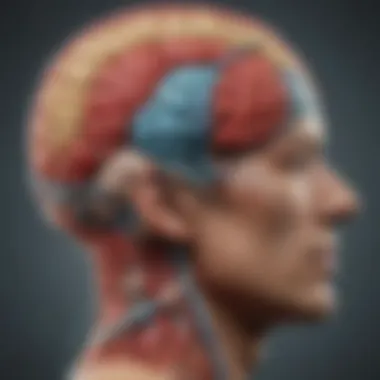Exploring the Forebrain: Key Insights into Cognition


Intro
The forebrain is a complex structure essential for various cognitive functions. As the largest part of the brain, it comprises several key areas that are crucial for processes such as memory, emotion, and reasoning. Understanding the forebrain's functions has become increasingly important in neuroscience, especially in relation to cognitive functionality and emotional regulation.
This review aims to synthesize the latest research findings regarding forebrain structure and its pivotal roles in cognitive processes. By doing so, it provides a comprehensive guide for students, researchers, educators, and professionals interested in the intricate workings of the forebrain.
Overview of Research Topic
Brief Background and Context
The forebrain contains critical components such as the cerebral cortex, thalamus, and hypothalamus. Each part plays a unique role in various cognitive tasks. For example, the cerebral cortex is involved in decision-making and problem-solving, while the thalamus acts as a relay station for sensory and motor signals. Recent studies have highlighted the importance of these structures, particularly in higher-order cognitive functions.
Importance in Current Scientific Landscape
In the current scientific landscape, understanding the forebrain is vital for comprehending neurological disorders. Knowledge of how the forebrain influences cognition can lead to advancements in treatment strategies for conditions such as schizophrenia, depression, and Alzheimer's disease. The relevance extends beyond clinical concerns, as researchers seek to unlock the mysteries of intelligence and decision-making hinges on the nuances of forebrain function.
Methodology
Research Design and Approach
The research methodology involves an extensive review of both qualitative and quantitative studies focusing on the forebrain. Articles published in peer-reviewed journals form the backbone of this evaluation. Various experimental designs, including longitudinal studies and case-control analyses, have been employed to explore the forebrain's influence on cognitive abilities.
Data Collection Techniques
Data collection for this review primarily utilized literature databases such as PubMed and Google Scholar. Key terms like "forebrain function," "cognitive processing," and "neuroscience" were used to locate relevant studies. Studies included were selected based on their scientific rigor, relevance, and contribution to current understanding. The analysis also incorporates different methodologies, such as functional MRI scans and electrophysiological recordings, to depict a holistic understanding of forebrain functionality.
Understanding the role of the forebrain can profoundly affect cognitive science and clinical practices.
Preamble to Forebrain
Understanding the forebrain is crucial in the realm of neuroscience. It is the largest part of the human brain and significantly contributes to various cognitive functions, emotional control, and voluntary actions. This article seeks to highlight the importance of the forebrain, focusing on elements like its anatomy, functionality, and its role in cognitive processes.
Research on the forebrain offers insights into how it processes information and interacts with different brain regions. By studying its structure and functionalities, we can gain a better understanding of behavior, memory, and decision-making processes. This knowledge is vital not only for academic education but also for clinical applications. It can shed light on disorders associated with the forebrain, thus addressing various mental health challenges.
Overview of Brain Anatomy
The anatomy of the forebrain is complex and intricate. It is primarily divided into two main parts: the telencephalon and the diencephalon. The telencephalon houses structures such as the cerebral cortex, which is essential for higher cognitive functions. This part is further divided into lobes, each responsible for different sensory and cognitive tasks.
The diencephalon includes crucial components such as the thalamus and hypothalamus, both playing key roles in regulating sensory information and homeostatic functions. The interactions between these regions contribute to the brain’s ability to function comprehensively. Moreover, the forebrain's connections to other brain areas demonstrate its integrative capabilities in neural processing.
Importance of the Forebrain in Neuroscience
The forebrain's significance in neuroscience cannot be overstated. It facilitates complex functions that define human behavior, such as learning, reasoning, and emotional responses.
- Cognitive Functions: The forebrain is instrumental in memory formation, problem-solving, and planning.
- Emotional Responses: It helps regulate emotions, impacting mental well-being and interpersonal relationships.
- Behavioral Control: The forebrain plays a vital role in voluntary motor activities.
Examining the forebrain enhances our understanding of cognitive functionality and helps identify areas needing intervention. This is particularly relevant in neurological disorders and mental health issues that stem from forebrain dysfunction. In summary, the forebrain's role is not only foundational but pivotal in ongoing neuroscience research.
Defining the Forebrain
Defining the forebrain is essential for understanding its intricate role in cognition and behavior. The forebrain encompasses structures that are integral to various higher-order functions. This section clarifies the anatomical layout and functional significance of the forebrain, allowing readers to appreciate its complexities and importance in neuroscience.
Forebrain Structure
The forebrain is one of the most crucial parts of the brain. It includes two main structures: the telencephalon and the diencephalon. Together, these structures govern a wide range of cognitive functions.


- Telencephalon: This part is highly developed and is involved in advanced cognitive tasks. It houses the cerebral cortex, which is responsible for functions like reasoning, problem-solving, and language. The telencephalon's ability to integrate sensory information makes it essential for interpreting the environment.
- Diencephalon: Positioned beneath the telencephalon, this structure primarily consists of the thalamus and hypothalamus. The thalamus acts as a relay station, transmitting information to the proper areas of the cortex. The hypothalamus regulates various autonomic functions, including memory and emotional responses.
By studying the forebrain's structure, we gain insights into how various regions collaborate to regulate thought processes.
Functional Regions of the Forebrain
Understanding the specific functional regions within the forebrain helps in grasping how these areas contribute to cognition.
Telencephalon
The telencephalon is known for its significant role in cognitive processes. One key characteristic is its expansive surface area, which allows for a greater number of neurons and synapses. This feature makes it a beneficial choice for examining cognitive functionality.
- Unique Feature: The folded structure of the cerebral cortex increases its area without enlarging the head. This characteristic facilitates more complex functionalities.
- Advantages: The heightened neuronal density translates into a more sophisticated capacity for processing information. However, one disadvantage is that its complexity can make it more susceptible to disorders like schizophrenia or dementia.
Diencephalon
The diencephalon is equally crucial. Its role in processing sensory information makes it a vital part of the cognitive system. A key characteristic of this region is its integration of emotional and memory-related functions.
- Unique Feature: The interplay between the thalamus and hypothalamus promotes coordination between emotional responses and sensory input. This integration is advantageous in understanding overall cognitive functionality.
- Advantages: It facilitates a comprehensive response to stimuli by merging emotional context with sensory experience. A disadvantage might be that dysfunction in this area can lead to significant disruptions in emotional regulation and behavioral adaptation.
"The forebrain is not just a collection of structures; it is a highly integrated system that underpins our cognitive abilities."
Cognitive Functions Associated with the Forebrain
The forebrain plays an integral role in various cognitive functions that shape human behavior and experience. Exploring cognitive functions associated with the forebrain is vital because these functions affect decision making, emotional regulation, and memory. The complexity of these processes highlights the forebrain's significance in both normal and abnormal psychology.
Understanding how cognitive functions develop, operate, and sometimes fail provides valuable insights for educators, researchers, and practitioners. Furthermore, advances in this area can guide therapeutic strategies for conditions where these functions are impaired.
Memory Formation and Retrieval
Memory is a cornerstone of cognitive function. It is essential for learning, adapting to new information, and personal identity. The forebrain, particularly areas such as the hippocampus and cortex, plays a pivotal role in memory formation and retrieval.
Memory formation begins with the encoding of information, which is then processed and stored for future retrieval. The hippocampus is crucial for forming new memories while the cerebral cortex retains long-term memories. Some key points regarding memory include:
- Types of memory: Declarative (explicit) and non-declarative (implicit).
- Encoding processes: Sensory input is translated into a format that can be stored.
- Cognitive loading: Increased cognitive load can hinder memory retrieval.
Research shows that engaging with memories can strengthen neural connections. Conversely, trauma or dysfunction in the forebrain may lead to memory loss or retrieval issues. The profound implications of memory on day-to-day life emphasize the need for further exploration in this field.
Decision Making
Decision making is another critical function linked to the forebrain. It involves evaluating information and outcomes before arriving at a conclusion. This process is not merely rational; it is influenced by emotions and past experiences, highlighting the intricate relationship between cognitive functions and emotional states.
The prefrontal cortex is central to decision making, supporting executive functions such as planning, reasoning, and impulse control. Decision-making processes can be categorized as:
- Rational: Based on logical reasoning and analysis.
- Intuitive: Driven by gut feelings and heuristics.
It is worth noting that different scenarios may activate various decision-making processes. This variability can explain why individuals can arrive at differing conclusions even with the same information. Moreover, disorders affecting judgment, like ADHD or schizophrenia, underscore the importance of studying these functions to enhance mental health strategies.
Emotional Regulation
The ability to regulate emotions is vital for healthy interaction and decision making. The forebrain's involvement in emotional regulation intertwines cognition with affect, illustrating how mental processes influence emotional responses and vice versa.
Key regions such as the amygdala and prefrontal cortex work together to manage emotional responses. Understanding emotional regulation encompasses:
- Identification of emotions: Recognizing personal feelings and the emotions of others.
- Coping strategies: Implementing effective methods to handle emotional distress.
- Influence on behavior: Emotions significantly impact choices and actions.
Impaired emotional regulation can lead to various mental health issues, such as anxiety and depression. Therefore, acknowledging the link between emotional regulation and forebrain activity is essential for developing effective therapeutic approaches.


Understanding cognitive functions associated with the forebrain is crucial for unlocking insights into human behavior and psychological well-being.
In summary, the exploration of cognitive functions like memory, decision making, and emotional regulation highlights the forebrain's role in addressing various aspects of mental health. Continued research into these areas can lead to improved educational strategies and clinical applications, ultimately benefiting a broad range of individuals.
Research Methodologies in Forebrain Studies
Research methodologies are integral to our understanding of forebrain functionality and its relation to cognitive processes. They facilitate exploration of complex brain activities and help link anatomical structures to behavioral and cognitive outcomes. Given the forebrain's role in higher-order functions, choosing appropriate methodologies is crucial for gathering reliable data and drawing meaningful conclusions. The methodologies employed can significantly impact findings and their implications for cognitive science, neuroscience, and psychological studies.
Neuroimaging Techniques
Neuroimaging techniques enable researchers to visualize and map brain structures and functions. Two prominent methods in this field are fMRI and PET scans, each offering distinct advantages.
fMRI
Functional Magnetic Resonance Imaging (fMRI) allows researchers to observe brain activity in real-time by measuring changes in blood flow. This method stands out due to its high spatial resolution, which aids in pinpointing the specific locations involved in cognitive tasks.
One key characteristic of fMRI is its non-invasiveness. Researchers can study participants without requiring any surgical procedures, making it a favorable option for many studies.
The unique feature of fMRI is its ability to produce dynamic images of brain activity over time. This capability enables insight into how different regions of the forebrain collaborate during cognitive processes. However, the technique has its limitations, such as sensitivity to motion, which can obscure results. Despite this, fMRI remains a powerful tool in discerning cognitive functions related to the forebrain, especially in studies of memory and decision-making.
PET Scans
Positron Emission Tomography (PET) scans provide another approach to studying brain function. PET is particularly useful for examining metabolic activities within the brain. It can measure glucose metabolism, linking specific areas to cognitive tasks and behaviors. This functionality is crucial when investigating neuroplastic changes and dysfunctions within the forebrain.
One of the main advantages of PET scans is their ability to assess neurotransmitter activity, which is vital for understanding chemical processes related to cognition and emotion. This technique can also be used to observe specific binding of radioligands to receptors, offering deeper insights into the neurochemical landscape of the forebrain.
However, PET scans involve the injection of radioactive tracers, which raises health concerns. This invasive nature and associated risks mean PET is generally used in studies requiring detailed metabolic activity analysis rather than general functional imaging. Despite these drawbacks, its ability to provide complementary data to fMRI makes it significant in the context of forebrain research.
Electrophysiological Methods
Electrophysiological methods involve direct measurement of electrical activity in the brain. Techniques such as Electroencephalography (EEG) and Electrocorticography (ECoG) enable real-time monitoring of neuronal activity, offering valuable insights into cognitive processes. They help researchers explore brain response patterns to various stimuli and tasks, providing a deeper understanding of temporal dynamics in forebrain function.
Behavioral Assessments
Behavioral assessments complement neuroimaging and electrophysiological methods. These assessments can include neuropsychological tests and observational studies. They allow researchers to correlate cognitive functions with observed behaviors, further revealing the complexity of forebrain-influenced activities. They can help identify functional impairments, contributing to our understanding of disorders related to forebrain dysfunction.
The integration of various methodologies strengthens our understanding of the forebrain's role in cognitive functionality. By utilizing a combination of neuroimaging, electrophysiological methods, and behavioral assessments, researchers can obtain a more comprehensive picture of how this critical brain region functions.
Recent Findings in Forebrain Research
The topic of recent findings in forebrain research is vital to understanding how this brain region intricately ties to cognitive functionality and emotional regulation. Modern-day neuroscience has revealed a wealth of knowledge that strengthens the link between the forebrain and various cognitive functions. Researchers are increasingly focused on unraveling these links due to their implications in both mental health and educational practices. This section highlights key advancements and explains their relevance in the broader scope of cognitive neuroscience.
Neuroplasticity and the Forebrain
Neuroplasticity is the brain’s ability to reorganize itself through the formation of new connections in response to learning or after injuries. This characteristic is especially notable in the forebrain. Recent studies have shown that the forebrain exhibits a remarkable degree of plasticity. This means that different cognitive processes can affect its structure and functionality. Such findings have significant implications, particularly for rehabilitation strategies following brain injuries. Understanding how the forebrain adapts allows for more personalized approaches to therapy and aids in optimizing cognitive recovery.
Impact of Forebrain Dysfunction
The dysfunction of the forebrain leads to a myriad of problems that span both neurological disorders and mental health issues. Investigating these areas can offer insight into how cognitive processes are disrupted and how they can potentially be improved.
Neurological Disorders
Neurological disorders such as Alzheimer’s disease, Parkinson’s disease, and multiple sclerosis can directly impact cognitive dimensions primarily regulated by the forebrain. A key characteristic of these disorders is the gradual degeneration of neural pathways and structural integrity within critical forebrain regions. This aspect is essential for framing discussions around cognition because it highlights the urgent need for therapeutic innovations. The identification of distinct neural markers related to these disorders presents a unique opportunity for targeted interventions that are currently under exploration.
Mental Health Issues
Mental health issues, including anxiety, depression, and schizophrenia, often reveal disruptions in forebrain functionality. A crucial trait of these problems is their complex nature, often involving biochemical and genetic factors at play. Highlighting these issues in the context of forebrain studies offers benefits by allowing researchers to focus on specific neural circuits that may be targeted for new treatment modalities. A unique feature of studying mental health through this lens is the potential to develop interventions that address underlying neural dysfunctions rather than merely treating symptoms. However, the multifactorial etiology of mental health issues means that such interventions are inherently more challenging to design and execute.


Implications of Forebrain Studies
The study of the forebrain has significant implications across various domains, including clinical practice, education, and research. A thorough understanding of forebrain functionality not only enhances our grasp of cognitive processes but also contributes to improving the methods used to address neurological and psychological disorders. Researchers and clinicians alike benefit from insights into how the forebrain operates in both healthy and dysfunctional states. This knowledge can foster the development of targeted therapies that can mitigate the effects of brain impairments.
Clinical Applications
Clinical applications of forebrain research are vast and varied. Knowledge about the structure and function of the forebrain can aid in diagnosing and treating several conditions, including:
- Alzheimer's Disease: Understanding how memory functions through the forebrain can aid in identifying targets for intervention, potentially slowing disease progression.
- Depression and Anxiety Disorders: Research shows that emotional regulation is primarily linked to forebrain activity. Treatments such as cognitive behavioral therapy (CBT) can be enhanced by insights from forebrain studies.
- Traumatic Brain Injury (TBI): Rehabilitation strategies can be informed by knowing which forebrain regions are affected and how they influence recovery and functionality.
- Attention Deficit Hyperactivity Disorder (ADHD): Insights into decision-making processes might lead to more effective treatment plans that align with cognitive capabilities affected by ADHD.
By applying findings from forebrain studies, healthcare professionals can tailor their approach, leading to more effective treatment modalities and improved patient outcomes.
Educational Strategies to Enhance Cognitive Function
In the educational realm, forebrain research informs strategies to enhance learning and cognitive function. Professionals in education can utilize this knowledge in the following ways:
- Tailored Learning Experiences: Understanding how the forebrain processes information can guide educators in creating personalized learning plans that accommodate individual cognitive strengths.
- Cognitive Training Programs: Using strategies that stimulate specific forebrain activities can lead to improved memory, attention, and problem-solving skills. Programs designed around neuroplasticity can guide students through techniques that harness their forebrain's ability to adapt and grow.
- Mindfulness and Emotional Understanding: Teaching students about emotional regulation can improve their interpersonal skills and enhance their learning environment. Studies indicate that mindfulness practices can positively impact forebrain connectivity.
Insightful research on the forebrain not only contributes to enhanced treatment options but can also revolutionize educational methodologies, ensuring that we cater to the unique cognitive profiles of each learner.
Future Directions in Forebrain Research
The forebrain holds crucial importance in understanding cognitive functionality, making it essential to explore future directions in research. These upcoming studies could significantly enhance our comprehension of cognitive processes, emotional responses, and overall brain health. Incorporating advanced technology and interdisciplinary approaches will likely yield profound insights.
Emerging Technologies
Technological advancements are key to unlocking deeper knowledge of the forebrain's complexities. Innovations such as functional MRI, which provides real-time insights into brain activity, have already transformed neuroscience. These techniques allow researchers to observe functional changes in the brain during different cognitive tasks. Similarly, optogenetics enables precise control of neuronal activity using light. This can elucidate how specific neurons contribute to behavior and cognition.
Moreover, the application of artificial intelligence poses vast potential for analyzing vast datasets from neuroimaging and electrophysiological studies. Machine learning algorithms might unveil patterns previously obscured in conventional analyses, providing fresh perspectives on cognitive functions associated with the forebrain.
In addition, wearable brain-monitoring devices may enable longitudinal studies on cognitive development over time, giving researchers a more comprehensive look into forebrain functionality in various populations.
Interdisciplinary Approaches
The complexity of the forebrain necessitates collaboration across diverse fields of study. Interdisciplinary research bridges neuroscience with psychology, education, and even philosophy. Such collaboration encourages innovative methodologies that enhance our understanding of cognitive processes.
For instance, integrating cognitive psychology with neuroscience helps elucidate the mechanisms behind memory and decision-making. This integration supports practical applications in clinical settings, such as cognitive behavioral therapy that aligns with neurological findings.
Moreover, partnerships among neuroscientists, psychologists, and educators can drive the development of teaching techniques that cater to various cognitive profiles. This also extends to understanding the emotional aspects of learning, which are tightly linked to forebrain activity. The uniqueness of each individual's neural wiring adds another layer to consider in educational strategies and developmental frameworks.
Interdisciplinary collaborations enrich the scope of forebrain research, leading to holistic insights that neither field could achieve alone.
In summary, future directions in forebrain research lie in embracing emerging technologies and fostering interdisciplinary collaborations. These paths hold the potential for innovative discoveries that can reshape our understanding of cognition and its underlying neural processes.
Finale
The conclusion serves as a vital segment in this article, emphasizing the significance of forebrain research in neuroscience. Understanding the forebrain's role is crucial for grasping the complexity of cognitive functionalities, emotional regulation, and behavioral adaptations. This section encapsulates the main findings and evaluates the impact of ongoing research on our comprehension of the brain. It reassures the audience of the relevance of studying the forebrain and motivates further inquiry into this intricate subject.
Summary of Key Points
In summarizing the key points presented in this article, it is crucial to highlight the following aspects:
- The forebrain encompasses two primary regions: the telencephalon and diencephalon. Each region plays an essential role in various cognitive functions.
- Cognitive functions such as memory formation, decision making, and emotional regulation are primarily mediated by the forebrain. This underscores its significance in both normal functioning and in cases of neurological disorders.
- Research methodologies, including neuroimaging techniques like fMRI and PET scans, allow for a better understanding of the forebrain's structures and functionalities.
- Recent findings illustrate the concept of neuroplasticity within the forebrain and its implications for mental health issues, suggesting that this area of study is evolving rapidly.
- Future research directions leverage emerging technologies and interdisciplinary approaches, which could enhance our understanding of cognitive processes significantly.
Final Thoughts on the Importance of Forebrain Research
The importance of forebrain research cannot be overstated. This area of neuroscience not only opens avenues for practical applications in clinical settings but also provides insights into foundational cognitive processes that define human behavior. The ongoing investigations into how the forebrain interacts with other brain regions will yield transformative knowledge about mental health, cognition, and overall brain functionality.
The understanding gained through current and future studies will inform educational strategies and clinical practices aimed at enhancing cognitive function. Moreover, this research has the potential to improve interventions for neurological and psychological disorders, ultimately contributing to the betterment of human health and well-being.
"Understanding the forebrain opens new doors in neuroscience, with implications for cognitive function, mental health, and educational advancement."
Thus, engaging with this field not only enriches our scientific knowledge but also directly impacts society at large by fostering a deeper understanding of what it means to think, feel, and behave.



